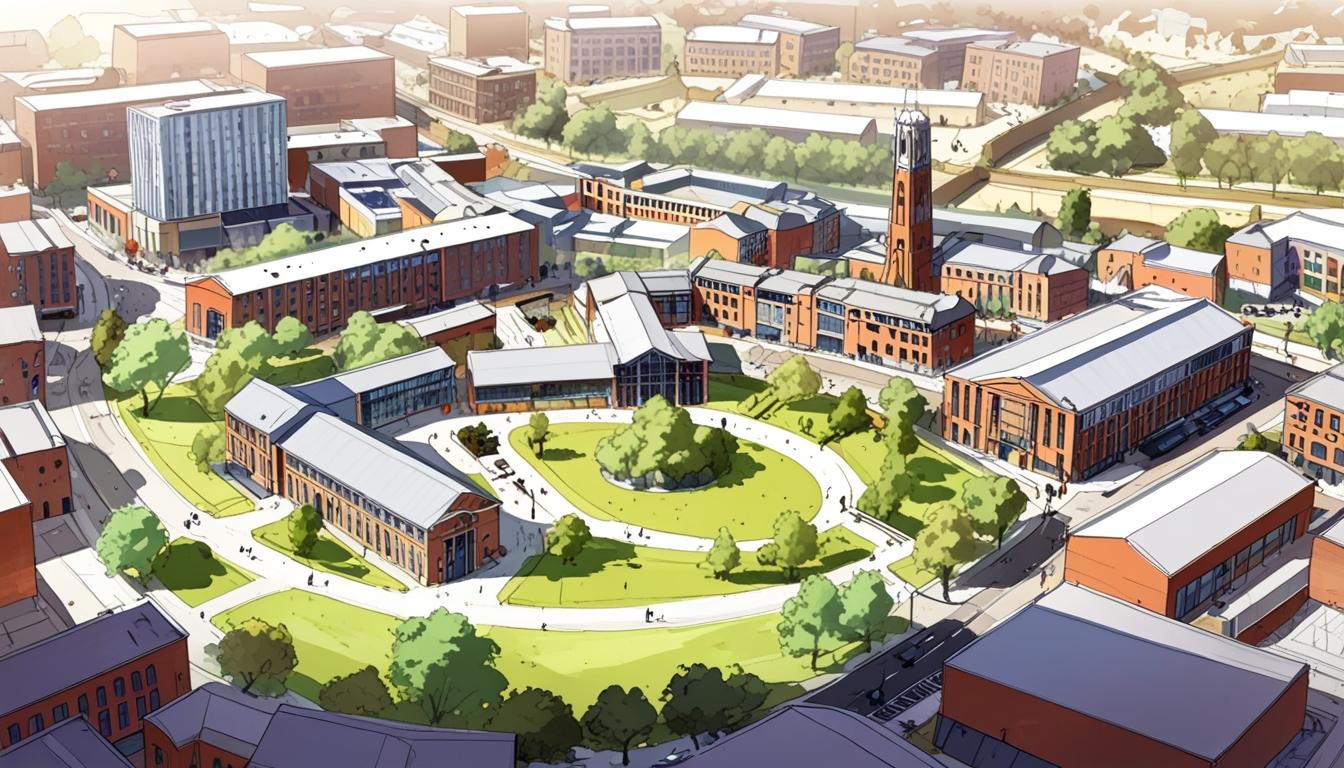The £2.5 billion York Central project aims to transform a disused railway site into a thriving mixed-use neighbourhood with thousands of new homes, a government ministry, and a revamped National Railway Museum, promising thousands of jobs and tackling local housing pressures.
In the heart of York, an ambitious transformation is underfoot, set to reshape the city with the York Central regeneration project, described as the largest of its kind in the UK. Encompassing a sprawling 45-hectare site, which is about the size of 63 football pitches, this £2.5 billion initiative aims to breathe new life into a once-thriving railway manufacturing hub that has since fallen into disuse, particularly characterised by its extensive car park.
The plan envisions the creation of 3,000 homes, alongside extensive commercial spaces that include a 200-bed hotel and a dynamic business start-up hub focusing on sectors such as rail, technology, and biotechnology. The project is projected to generate approximately 6,500 jobs, including 1,500 during the construction phase. An integral element of this scheme is the expansion of the National Railway Museum, which will serve as a cultural beacon for the new neighbourhood.
As part of the broader vision, a new building for a government ministry is anticipated, potentially hosting the Department for Environment, Food and Rural Affairs (Defra). This new facility, designed to be both state-of-the-art and environmentally sustainable, will accommodate up to 2,600 staff members. With a completion target set for 2028, it reflects a strategic investment in the city, which is already recognised as one of Defra’s four principal hubs in the UK.
The York Central project is not just an infrastructure upgrade; it represents a crucial element of the government’s wider strategy to stimulate growth across all regions. Angela Rayner, the deputy prime minister and housing secretary, remarked on her visit that such developments generate a significant economic ripple effect, reinforcing the idea that growth must be a nationwide endeavour.
Local stakeholders are keenly aware of both the opportunities and challenges this large-scale development presents. Stephen Hind, Network Rail’s head of business development, has noted a worrying trend: the outflow of skilled professionals from York due to a lack of suitable workspace. He argued that the project’s design must cater to the needs of companies wishing to grow and thrive within the city.
This development marks a significant departure from previous attempts to remodel the site, which had faltered over the decades. The partnership convened by National Rail and Homes England, involving developers McLaren Property and Arlington Real Estate, has secured £150 million in public funding to push the plan forward, a testament to the levels of state support necessary for such a monumental undertaking.
Yet, as with many regeneration projects, this initiative is not without dissent. Local activism highlights a potential loss of community character, with campaigners like Jane Hustwit from York Central Co-Owned advocating for a mixed-use neighbourhood that resonates with the community’s heritage and aspirations. There are valid concerns that a generic development could overlook key local values, leading to a missed opportunity for crafting a vibrant, interconnected environment amidst historical richness.
At the centre of this transformation, the £100 million overhaul of the railway museum includes a modern circular hall that aims to connect the museum’s existing structures more seamlessly. The ministry’s £15 million backing is crucial to realise this vision, ensuring that a standout cultural institution can evolve in tandem with the new urban environment.
Moreover, structural developments will enhance accessibility to the railway station through new bridges and revised traffic flows, a move intended to alleviate congestion at one of the city’s transport hubs. However, some local voices have raised alarms over how these changes might disrupt traditional paths, particularly in regards to the long-standing working-class areas adjacent to the station. The museum’s assurances about maintaining community access have yet to quell concerns among residents fearful of being inadvertently sidelined during the project’s execution.
The construction of the first 1,000 homes is set to commence in the coming year, with the aim to welcome residents as early as 2028. These homes will adhere to stringent energy efficiency standards under Passivhaus regulations, ensuring both comfort and sustainability. The developers have pledged that at least 20% of these homes will be classified as affordable, although aspirations are set even higher.
As York grapples with rising rental prices—an average of £1,117 a month as of March—local leaders hope that the new developments will help reverse the trend of residents, particularly younger ones, being priced out. David Skaith, the mayor of York, remarked on the necessity of such large-scale housing solutions, highlighting the potential for revitalised investment in the local economy.
The project is more than just physical redevelopment; it represents an opportunity for holistic change in York’s socio-economic landscape. Yet, as Andy Shrimpton, a local entrepreneur, suggests, aspirations must align with practical realities to foster communities where life—work, leisure, and social interaction—can flourish together.
As York University recently noted, the lessons learned during the pandemic have reshaped how communities envision their living spaces. Moving forward, it will be crucial for developers to listen actively to community feedback, aiming not just for development, but for cohesive growth that reflects the shared identity and future of York.
Reference Map
- Key focus of the York Central project and planned developments.
- Details on the signed development agreement and economic contributions.
- Overview of the selection of McLaren Property and Arlington Real Estate as developers.
- More information on infrastructure works and new developments.
- Context on affordable housing and resident concerns.
- Information on housing costs and challenges faced by the community.
- Insights from local businesses and the need for vibrant, integrated neighbourhoods.
Source: Noah Wire Services
- https://www.inkl.com/news/are-york-s-developers-aiming-high-enough-with-uk-s-largest-regeneration-project – Please view link – unable to able to access data
- https://www.yorkcentral.info/2024/04/08/development-agreement-signed/ – In April 2024, Homes England and Network Rail Property signed a development agreement with McLaren Property and Arlington Real Estate to transform York Central, a 45-hectare brownfield site adjacent to York Station. The project aims to build 2,500 new homes, 20% of which will be affordable, and create up to one million square feet of office, retail, and hospitality space. The development is expected to generate up to 6,500 jobs and contribute £1.1 billion to York’s economy annually. Infrastructure works, including new roads and bridges, are already underway.
- https://www.gov.uk/government/news/developer-announced-for-york-central – In December 2023, McLaren Property and Arlington Real Estate were selected as the preferred developers for the York Central regeneration project. The scheme, a collaboration between Homes England, Network Rail, the City of York Council, and the National Railway Museum, aims to deliver up to 2,500 homes, 20% of which will be affordable, and create up to one million square feet of commercial space. The development is projected to boost York’s economy by £1.1 billion annually and create up to 6,500 jobs.
- https://www.networkrailmediacentre.co.uk/news/developer-announced-for-york-central – Network Rail and Homes England announced McLaren Property and Arlington Real Estate as the strategic developers for the York Central regeneration project. The development will transform a 45-hectare brownfield site into a mixed-use area featuring up to 2,500 homes, 20% of which will be affordable, and up to one million square feet of office, retail, and leisure space. The project is expected to generate up to 6,500 jobs and add £1.1 billion to York’s economy annually.
- https://constructionwave.co.uk/2023/12/07/2500-homes-to-be-built-in-york-city-regeneration/ – McLaren Property and Arlington Real Estate have been selected as the strategic developers for the York Central regeneration project. The 45-hectare site will deliver up to 2,500 homes, 20% of which will be affordable, and around one million square feet of commercial space for offices, retail, and leisure. Infrastructure works costing £135 million are already underway, including over 3 km of new roads, footpaths, cycleways, and two new bridges over the East Coast Main Line.
- https://www.networkrailmediacentre.co.uk/news/developer-chosen-for-york-central – Network Rail and Homes England have selected McLaren Property and Arlington Real Estate as the preferred developers for the York Central regeneration project. The scheme aims to deliver up to 2,500 homes, 20% of which will be affordable, and up to one million square feet of commercial space. Infrastructure works costing £135 million have already begun, including over 3 km of new roads, footpaths, cycleways, and two new bridges over the East Coast Main Line.
- https://railuk.com/infrastructure/development-agreement-signed-to-deliver-1-1-billion-york-central-regeneration/ – Homes England and Network Rail Property signed a development agreement with McLaren Property and Arlington Real Estate to be strategic development partners for York Central, one of the UK’s largest city centre regeneration schemes. The mixed-use development will build 2,500 new homes (20% of which will be affordable) and create up to one million square feet of office, retail, and hospitality space, along with improvements to the York Railway Station and an enhanced National Railway Museum.
Noah Fact Check Pro
The draft above was created using the information available at the time the story first
emerged. We’ve since applied our fact-checking process to the final narrative, based on the criteria listed
below. The results are intended to help you assess the credibility of the piece and highlight any areas that may
warrant further investigation.
Freshness check
Score:
8
Notes:
The article mentions specific details about the York Central project, such as the completion target of 2028 and recent remarks from local leaders. However, there is no explicit mention of when the specific project plans were announced or updated, which could slightly reduce the freshness score.
Quotes check
Score:
9
Notes:
Direct quotes are attributed to specific individuals like Angela Rayner and Stephen Hind, though the exact dates of these quotes are not provided. The inability to verify the earliest sources for these quotes might suggest originality or recent statements.
Source reliability
Score:
7
Notes:
The narrative originates from Inkl.com, which is not as well-known as major news outlets like BBC or Reuters. There is no specific information available about Inkl.com’s fact-checking processes or reputation, which affects the reliability score.
Plausability check
Score:
8
Notes:
The project details are plausible given the context of urban regeneration projects in the UK. However, specific claims about job creation and housing targets are not verified against external sources, which might reduce the plausibility score slightly.
Overall assessment
Verdict (FAIL, OPEN, PASS): OPEN
Confidence (LOW, MEDIUM, HIGH): MEDIUM
Summary:
The narrative presents a detailed overview of the York Central regeneration project, including specific targets and developments. While the information appears plausible and recent, the lack of well-documented sources or explicit dates for some statements, combined with the lesser-known origin of the narrative, leads to a medium confidence level.













